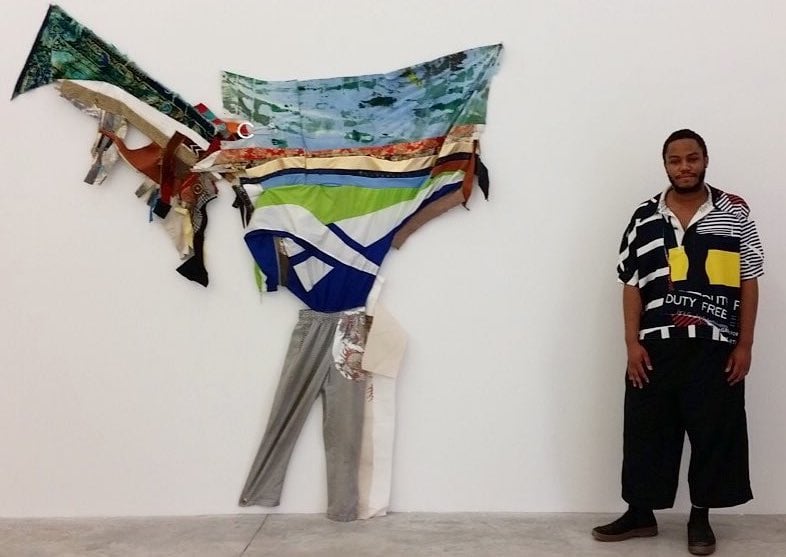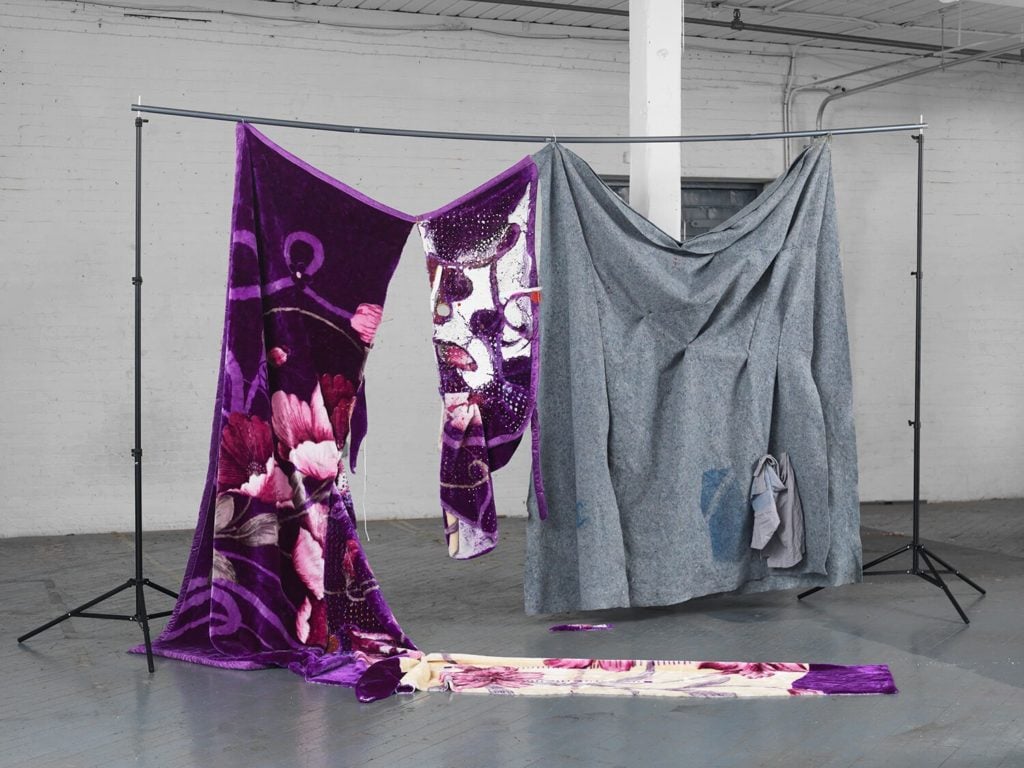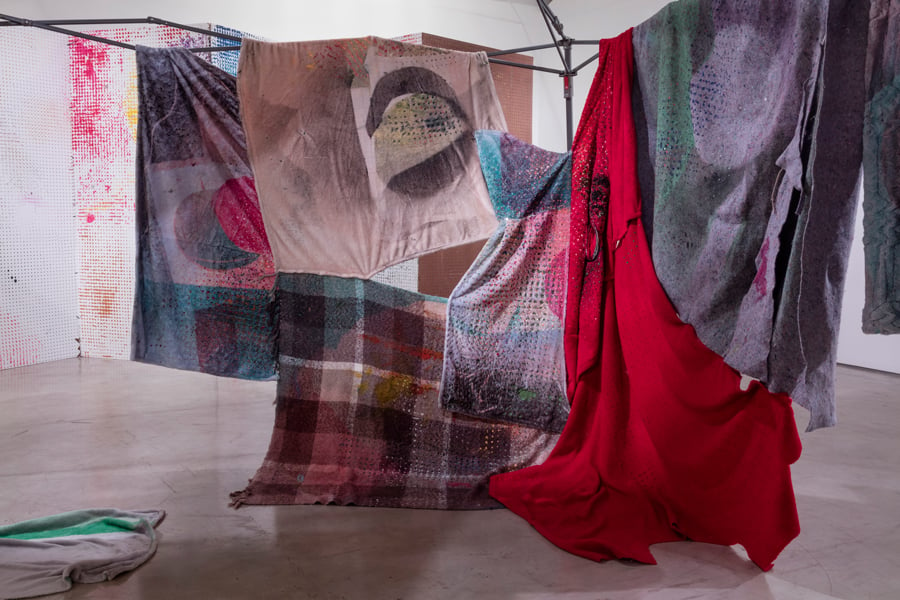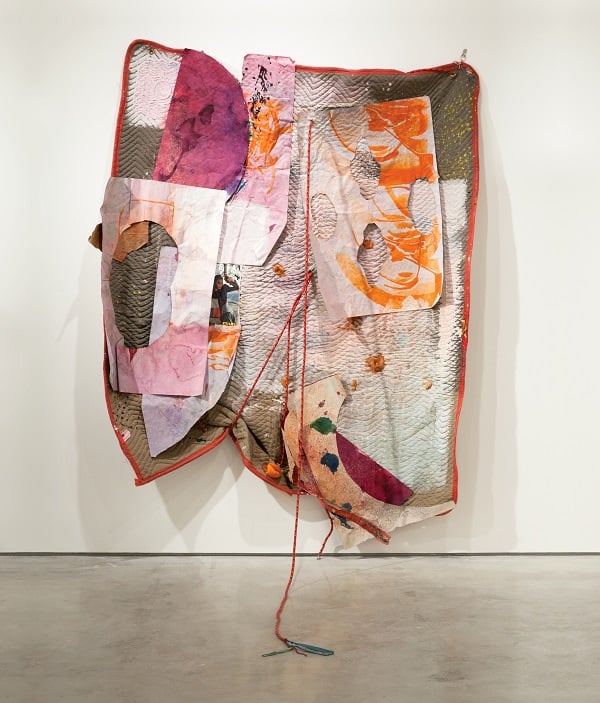On View
Emerging Star Eric N. Mack on Painting Outside of the Frame and Growing Up in a Museum
"Vogue Fabrics," the artist's first solo museum show, is on view at the Albright Knox.

"Vogue Fabrics," the artist's first solo museum show, is on view at the Albright Knox.

Henri Neuendorf

The works assembled in Eric N. Mack’s cavernous South Bronx studio are about to be packed and shipped to Buffalo for the 30-year-old artist’s first solo museum exhibition at the Albright Knox.
Pieces of fabric, rags, moving blankets, piles of books, magazines, and photographs are strewn across the floor, loose components that go into the artist’s paintings. While he refers to himself as a painter without hesitation, Mack’s work rarely, if ever, takes the shape of the traditional canvas-on-stretcher format. Instead the artist’s work resembles drapey assemblages of sewn-together bits of painted-on fabric that take on architectural and installation-esque characteristics.
Mack himself cites Robert Rauschenberg and Sam Gilliam as influences, but to compare him to these artists belies the complexity and dexterity of his work. Each component has a specific resonance that is amplified when assembled. When I visited his studio to see his works, Mack’s friend, the Iranian artist Ala Dehghan, excitedly pointed out that a shroud within one of the patchwork tapestries was a gift from her.
A lot of Mack’s work revolves around the idea of re-use, and how the context or setting of different materials influences value and identity. Why can’t a found rag be beautiful? What can’t it be valuable? And what does our perception of what we value say about us as individuals and as a culture?
And the culture at large has taken notice of his work. He is a graduate of the prestigious Studio Museum residency, participated in a two-person show at Paris’s Almine Rech gallery, was recently signed to Simon Lee Gallery’s roster, and was just announced as a winner of the 2017 BALTIC Artist’s Award.
The first thing you notice about Mack in person is his outfit, which almost looks like an extension of his art, a flourish in some Beuysian Gesamtkunstwerk. He speaks very thoughtfully in a quiet tone, pausing often to think about an answer before he articulates it. Recently, we met for an interview at artnet’s offices in downtown New York to discuss his work, his exhibition at the Albright Knox, and what it was like growing up, literally, in a museum.
Is it true that your parents both worked and met at the National Gallery of Art? How did this upbringing shape your understanding of art?
Art has always been in very close proximity to me. I remember that going to work with my Dad [a display expert at the National Gallery] was one of the most exciting things as a kid. Going behind the scenes at the museum was thrilling. I felt very tied to the work around me, almost as if I had ownership of the museum.

Eric N. Mack, In Definitely Felt (2016). Photo: Courtesy of the artist and Moran Bondaroff, Los Angeles.
So you were exposed to a lot of art from an early age?
It was just there. As a kid you would only go to museums on a field trip, so to be able to go with your Dad to his workplace and see such a wide range of things was significant. I never thought that I would become an artist, even though I definitely had artistic inclinations. The work that I saw at the National Gallery was by figures like Van Gogh, so I wasn’t totally aware of artists who were living and working. But being able to be there with my whole family and see those things was something that brought me close to art.
For work, my Dad would build vitrines and help with the architecture of the exhibitions. So I saw this slippage between the artwork and the way it was being presented, this correspondence in aesthetic. He’d put the artwork in a context that would do justice to the art object, but also allow its presentation to reflect the aesthetic of the National Gallery, which is the type of institution where the walls aren’t painted white. For example, there was this greenish hue to help contextualize the Van Gogh exhibition, I remember. Those details really stick with me.
And it wasn’t only traditional painting that I saw at that time. There was an art nouveau exhibition and others that are still stuck in my head—really impactful, grand things.
I think my cousin worked there at a certain point too, helping my Dad. It was very much a place that was a home for me. If I go there today I’m sure there would be some security guards that would be like, “You look just like your mom.” That actually happened to me a few years ago, which was so crazy!
It’s interesting that you refer to yourself as a painter, yet your work doesn’t take place on a canvas. How far can you stretch the boundaries of painting outside of the canvas?
I think painting can go as far as we can think. There’s a kind of utility to the idea of painting as a medium that I love, because of its particular setting, the variations of lacquers, the points of manipulation, the spacial aspects. The way that I think about painting is as a combination of gesture and the trace of the hand and the way that the painter manipulates shapes into a kind of emotional space.
A lot of my work started off by thinking about stained painting. That was when things started to really click for me. Thinking about art history and the collapse between life and aesthetics, and being able to conceptualize painting as a matter of complex objects and how paint can change a surface, opening it up to not only thinking about canvas or wood, but signage, graffiti, and different points of reference.
I think everything I bring in comes back to the aesthetics of painting. But because my work reaches so far outside of painting, and often grounds itself in sculpture or architecture, I also think you’re able to see painting in its most dynamic state.

Eric Mack Tent (2015). Photo: Courtesy of the artist and Moran Bondaroff, Los Angeles.
What is behind the recurring use of fabrics and quilts in your assemblages?
I’ve been thinking a lot about what makes something valuable, what makes something authentic and special. Not necessarily what makes something an art object, but the difference between seeing things around me as authentic, beautiful, intriguing, special, or whatever.
It has a lot to do with the care by which something is made by hand. Quilting takes genuine skill in the way that pieces come together to make something that is useful at its most basic level. At the same time, there’s something about quilting that’s highly delicate. I think about the Southern tradition of quilting. Those quilts have such a particular abstract aesthetic.
I mostly use moving blankets. They’re industrially made and sometimes they have really interesting fabric selections, patterns and things like that. But for the most part they’re chevron patterns of embossed thread lines.
Is fashion something you look at?
Yeah, fashion is really very interesting to me. I find it really compelling, even if it’s just the push of an aesthetic or how an idea can translate into everyday life, like people wearing something in the street that would normally be used in a different context. Also the cyclical nature of fashion—bellbottoms are in again, or whatever.
Fashion is not just purposeless, it definitely communicates something about contemporary culture in the same way that art can. But fashion is compelled to change more quickly so you always have to keep up to follow its trajectory.
You’ve referenced Robert Rauschenberg and Sam Gilliam as influences. How did these artists shape your thinking?
Especially in grad school, my indebtedness to Rauschenberg or Johns was overwhelming. I like their work a lot, of painting as a way of thinking. Both of those artists were able to speak to everyday life, and to the everyday presence of abstraction in a compelling way.
Then there’s the influence of stain painting. I’m really trying to consider its importance as a point of reference. Sam Gilliam is definitely a monumental figure for me. There’s something about his drape works from the 1970s, about those paintings and their relationship to architecture, that has been a point of research for me. I’m definitely seeking to expand upon what he invented.
Can you explain some of the political nuances in your work?
A lot of the political frame comes from wanting to talk about and wanting to relate the work to identity through the use of abstraction, and thinking about the use of a fragment. A lot of that comes through in the relationships between the pieces of fabric and where that fabric comes from.

Eric Mack, Pain After Heat (2014). Photo: Courtesy of the artist and Moran Bondaroff, Los Angeles.
Tell me about your artistic process.
I would describe the studio as a place that has its own ecology, a space to create a single outcome from different variables. I need that freedom to develop the structures and identities in the work. I like really thinking about the notions of hybridity or heterogeneity. Introducing a new material or new surface, I really believe that it will be changed by applying paint to it, really dealing with abstraction in a physical way.
Tell me about your show at the Albright Knox.
The show is about the materiality of the works and how they express themselves. I felt I really had to consider how the viewers would travel around the space. What I’ve been trying to get at with this show is having the viewers deal with abstraction as a form of withholding or obscuring—there are a lot of transparent and gauzy surfaces that you can look through. There’s a lot of silk and saturated color.
The show is called “Vogue Fabrics.” When I visited London several months ago my friend took me to this clubby bar called Vogue Fabrics in Dalston. I was struck by the fact that it was named after a fabric store and the accumulation of the name’s meaning, alluding to the dance, the magazine, and the nature of contemporary culture. I like the transfer of meaning, and that’s true for a lot of the titles in the show.
I like the fact that the work itself has a provocative relationship with the viewer. As the viewer moves around, new things become visible, and that’s an important part of the experience. The works are in their most active state when they fill an exhibition space, when they aren’t compositionally stagnant, but an experience for the viewer.
If you could own any artwork from art history, what would it be and why?
I would put two strange works together, things that I would maybe not ever see. So I’d like some Water Lilies, like the one in a curve. But I’d have to have a Robert Colescott. Yeah, I’d put the Colescott right next to the Monet.